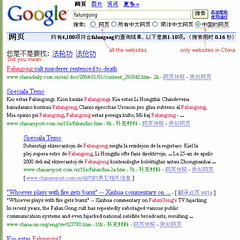Haloscan commenting and trackback have been added to this blog.
SDI
♪すいか泥棒 英語版 -Suika Dorobo supports Takeshima's Day-
Tuesday, January 31, 2006
Saturday, January 28, 2006
Some little things you can do for stopping Google China's censorship

- Checking Chinese Google Results
- Google China censorship fuels calls for US boycott - The Boston Globe
To make sure what Article 1 says is true, I tried just the same. Here's what you should do if you're going to try it:
- Flush all your browser's cookies related to domain "google.com.cn".
- Set your browser's language to "Chinese (simplified)" (i.e. make your browser say "Accept-language: zh-CN" in HTTP request.)
- Access http://www.google.com.cn/, and type any "sensitive" keywords (in Chinese authoritie's sence, of course) you can think of.
You'll get a search result like this:
You can easily see that the result contains only websites in China.
Now let's try broadening the range of search to all the websites in the world: you'll see a set of radio buttons just below the keyword input box. Check the left-most one, which means "all the websites", and redo the search.
You'll get just the same result as you did last time, with "all the websites" button unchecked (and "only websites in China" button checked again). Google China doesn't allow you to search for some "sensitive" contents abroad. The same thing occurs if you search in Chinese (example: here I tried "tiananmen 6.4"). It's worth paying attention that this sort of filtering is functioning not only for accesses from within China but for accesses from all over the world (I live in Japan) just as long as the browser's language preference is set to Chinese (simplified).
You want to call Google for stopping its assistance of Chinese communists' internet censorship? But you don't have any Google stock to sell out? I don't either, and I even can't quit using Google for now ;)
If you're a Firefox user, it might be a good idea
to install Adblock
and add a new filter, *.googlesyndication.com/*.
(To be honest, I have been doing this for months)
Tags: censorship China falungong falun gong Gmail Google Tiananmen
Wednesday, January 25, 2006
Hwang Woo-suk shock is not enough to stop Korean daydream?
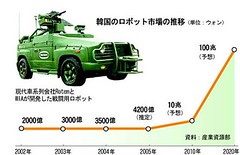
I found this graph at this news. It shows the growth of South Korea's domestic market in robot indutry, predicted by Korean Ministry of Industry and Resources. Possibly encouraged by Hyundai's entrance in intelligent robot manufacturing, Korean government is expecting their robot market, estimated USD 420 million in the year 2005, to grow as large as USD 10 billion in 2010, and USD 100 billion in 2020.
Frankly, I was always wondering what could make Koreans optimistic like this, even just after they learned the true position of their country in the field of science and technology (through Hwang Woo-suk's scientific fraud incident, for instance). Later I found a simple and persuasive answer to my question: "maybe the graph is just predicting a catastrophic infration in Korea in the near future."
Wednesday, January 18, 2006
Koreans to audit what?
I found this news at GI Korea Blog today:
Korea named deputy for tsunami fund audit (JoongAng Ilbo, Jan 18 2006)
BTW If the reader has not ever tried UN OCHA(Office for Coordination of Humanitarian Affairs)'s financial tracking service, I recommend you to visit the link and try
Donor: Korea, Republic of Country / Emergency: INDIAN OCEAN - Earthquake / Tsunami
You'll get $6,100,000 in total, whereas if you sum up "paid contribution" only, you get $2,950,000. Here I pasted the bulk HTML code of the tables as follows, since the result page has no parmalink:
| Description | Donor Country | Status | Amount in USD |
|---|---|---|---|
| (Region) Balance of uncommitted pledge (originally USD 5 million) to various projects in Tsunami Flash Appeal | Korea, Republic of | Pledge | $3,000,000 |
| (Region) Awaiting allocation to specific country and sector | Korea, Republic of | Paid contribution | $1,000,000 |
| (Region) Special Operation for WFP Air Support of Humanitarian Relief Operations in Response to the Indian Ocean Tsunami | Korea, Republic of | Paid contribution | $500,000 |
| (Region) Humanitarian assistance to tsunami-affected population | Korea, Republic of | Paid contribution | $500,000 |
| (Indonesia) Cash (Part of 600,000) | Korea, Republic of | Paid contribution | $200,000 |
| (Sri Lanka) Cash (Part of 600,000) | Korea, Republic of | Paid contribution | $200,000 |
| (Indonesia) Temporary shelter, health clinics, IDP management and family reunification | Korea, Republic of | Paid contribution | $198,000 |
| (Sri Lanka) Medical and psychosocial community support to the displaced populations | Korea, Republic of | Paid contribution | $170,000 |
| (Indonesia) Temporary shelter, health clinics, IDP management and family reunification | Korea, Republic of | Paid contribution | $132,000 |
| (Thailand) Cash for emergency assistance (part of $600,000 regional pledge) | Korea, Republic of | Commitment | $100,000 |
| (Maldives) Cash for emergency assistance (part of $600,000 pledge) | Korea, Republic of | Commitment | $50,000 |
| (Malaysia) Cash for emergency assistance (part of U$600,000) | Korea, Republic of | Paid contribution | $50,000 |
| (Sri Lanka) Dispatch of 5.2 tonnes medicines by military air transport | Korea, Republic of | Commitment | $0 |
| (Sri Lanka) Dispatch of 'Korean Disaster Relief Medical Team' (36 personnel* | Korea, Republic of | Paid contribution | $0 |
| (Thailand) Dispatch of '119' rescue team* | Korea, Republic of | Paid contribution | $0 |
| TOTAL : | $6,100,000 |
| Description | Donor Country | Status | Amount in USD |
|---|---|---|---|
| (Region) Awaiting allocation to specific country and sector | Korea, Republic of | Paid contribution | $1,000,000 |
| (Region) Special Operation for WFP Air Support of Humanitarian Relief Operations in Response to the Indian Ocean Tsunami | Korea, Republic of | Paid contribution | $500,000 |
| (Region) Humanitarian assistance to tsunami-affected population | Korea, Republic of | Paid contribution | $500,000 |
| (Sri Lanka) Cash (Part of 600,000) | Korea, Republic of | Paid contribution | $200,000 |
| (Indonesia) Cash (Part of 600,000) | Korea, Republic of | Paid contribution | $200,000 |
| (Indonesia) Temporary shelter, health clinics, IDP management and family reunification | Korea, Republic of | Paid contribution | $198,000 |
| (Sri Lanka) Medical and psychosocial community support to the displaced populations | Korea, Republic of | Paid contribution | $170,000 |
| (Indonesia) Temporary shelter, health clinics, IDP management and family reunification | Korea, Republic of | Paid contribution | $132,000 |
| (Malaysia) Cash for emergency assistance (part of U$600,000) | Korea, Republic of | Paid contribution | $50,000 |
| (Thailand) Dispatch of '119' rescue team* | Korea, Republic of | Paid contribution | $0 |
| (Sri Lanka) Dispatch of 'Korean Disaster Relief Medical Team' (36 personnel* | Korea, Republic of | Paid contribution | $0 |
| TOTAL : | $2,950,000 |
Chosun Ilbo's editorial on Dec 27 2004 says:
Our government earned itself international kudos by deciding yesterday to send US$600,000 (W628.6 million) in relief funds and assistance.
If this is not a typo, Korean government apparently ended up in pledging to pay over 10 times as much as they had originally expected (and actually paying under half of it, as shown above); it might make you kinda confused if you know that the same newspaper says, in its Japanese edition, that Korean government is considering to increase its Tsunami aid up to over 50 million US$.
Tags: Korea tsunami UN United Nations
Monday, January 16, 2006
Overlapping Hwang's photos of "two different stem cells"
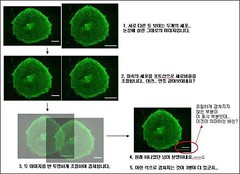
I found this pic at this news last month. It was originally uploaded on a S.Korean photo fan site in early December 2005, the news says.
The pic above shows how the guy collected the photos used in Hwang's "Science" paper, picked up two of them, adjusted their aspect ratio, and found out that the two photos perfectly overlap.
"The paper says these two photos are of two different stem cells, but it's clear they're duplicated from a single source photo," says the creator of the pic, "I've found three more pairs of photos that overlap just the same way."
These sort of "take-two-and-overlap" games were played not only with Hwang's micrographs, but also with the DNA fingerprint spectra of the "stem cells" in the suspected paper. This eventually provoked scientists in / outside Korea to request Seoul National Univ for inspection on the entire process of Hwang's research.
It seems that so many Korean mass media are still attempting to attribute the disclosure of Hwang's data fabrication to "young Korean scientists" (like those seen in BRIC): if you take a glance at a local newspaper, you'll easily find editorials and columns saying
"Although Hwang's achievements were all found out to be fabrications and Korea's dream of the first Nobel Prize winner in the field of science has ended up in ruins, nevertheless there's a hope left for us, as long as we have these young and excellent scientists."
"We don't need to be so much pessimistic over the future of scientific research in our country: Korean scientists unveiled their colleague's fabrications by themselves, thereby showing us the integrity of our society."
etc, etc...
It is obvious that the disclosure should actually be attributed to so many players of the "take-two-and-overlap" games, like the creator of the above pic. All the "young Korean scientists" did was the advocation of launching the Univ's inspection team.
Well, anyway don't get down too much, Korean friends, you still have a chance to win the world's first "Nobel Photo-Shop prize" or something like that. Sounds splendid, huh? :-p
Saturday, January 14, 2006
Recommended Flash Movie
Most of the scenes in the movie were taken during the FIFA World Cup soccer games held in 2002. Unfortunately I can't read Italian, but I bet just looking at the pictures is more than enough to get what the creator wanted to tell us about: you can see what Korean manner of "sportsmanship" is like, or maybe Korean way of "patriotism" as well.
If the movie above is inaccessible to you, try this article (in Japanese): you can see some snapshots from the movie and some additional info there.
A Hwang Woo-suk Stamp
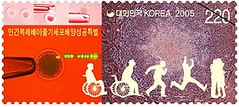
I found this pic at a news article in Chosun Ilbo website. The stamp was originally issued in Feb 2005 for commemorating Hwang's "success" in cultivating hESC, the news says.
Well, that's okay: what I can't understand is that this stamp, according to the news, was sold more than before once Hwang's achievements, represented by the two notorious "Science" papers, were all found out to be fabrications.
You see, even a fraud can be a hero in this country, just as long as he succeeds in advertising his trick as "an epochmaking scientific finding". It seems that Koreans don't care if his work is scientifically reliable or not: they still don't even realize scientists must not write a paper with fake data; In other words, Koreans are satisfied with such a fake science just as long as it provides them of an opportunity of earning money by what they call "source technology" (if any), and of promoting Korea as "a leading nation in bio-tech field".
Friday, January 13, 2006
Summary of the "Final Report" on Hwang's Research Allegations (NY Times)
Here's the "final" report on Hwang's fake papers, presented on Jan 10 (local time) by Seoul Univ. See a local news page for original version in Korean. Japanese readers could also visit my main blog (in Japanese) for Japanese translation.
Summary of the Final Report on Professor Woo Suk Hwang's Research Allegations by Seoul National University Investigation Committee
The Seoul National University Investigation Committee, initially organized to investigate the claims of scientific misconducts associated with the research article published in 2005 in the journal Science by Professor Woo Suk Hwang and co-workers (Hwang et al., 2005), expanded its scope of investigation to determine the facts and truth regarding another article in the same journal published in 2004, the cloned dog, Snuppy, the technical expertise of Professor Hwang's research team, and the process of obtaining human eggs.
Today we submit the final report based on our investigative effort from December 15th of 2005 to January 9th of 2006. Here is a brief summary of our report.
1. 2005 Science paper
(Hwang WS, Roh SI, Lee BC, Kang SK, Kwon DK, et al. 2005. Patient-specific embryonic stem cells derived from human SCNT blastocysts. Science 308: 1777-1783)
This article claimed that 11 human embryonic stem cell lines have been established through transfer of somatic cell nuclei. In interim reports we issued previously, we already reported that data from only two embryonic stem (ES) cell lines have been used for this publication and that even these two lines are not derived via somatic cell nuclear transfer (SCNT) but from in vitro fertilized (IVF) eggs. The stem cells that Professor Hwang claims to have created subsequent to the 2005 publication were also turned out to have originated from frozen fertilized eggs and not from cloned blastocysts. The data in 2005 article including test results from DNA fingerprinting, photographs of teratoma, embryoid bodies, MHC-HLA isotype matches and karyotyping have all been fabricated. The method and process of fabrication are described in the report. In conclusion, the research team of Professor Hwang does not possess patient-specific stem cell lines or any scientific bases for claiming having created one.
2. 2004 Science paper
(Hwang WS, Ryu YJ, Park JH, Park ES, Lee EG, et al. 2004. Evidence of a pluripotent human embryonic stem cell line derived from a cloned blastocyst. Science 303: 1669-1674)
The investigation on the 2004 Science paper in which the establishment of the first human ES cell line from cloned blastocyst was reported was initiated in response to various doubts raised on photographs of the cells and results from DNA fingerprinting analyses.
The committee has undertaken DNA fingerprinting analyses on the samples obtained from the ES cell line in question (NT-1), teratoma allegedly derived from NT-1, and the donor (donor A) of the egg and somatic cell. The DNA samples for the ES cell line included those from 20 subcultured NT-1 cell lines in culture or in frozen state from Professor Hwang's laboratory, one deposited to the Korean Cell Line Bank for the purpose of securing a patent, one maintained in Professor Shin Yong Moon's laboratory at SNU, and one maintained in the MizMedi Hospital. The 23 samples were examined by three independent test centers, and all three centers have obtained identical results.
The teratoma, the cell line deposited in the Korean Cell Line Bank, and the cell lines maintained in Professor Moon's laboratory and in the MizMedi Hospital all showed an identical fingerprinting pattern. Among the twenty independent subcultures from Professor Hwang's laboratory, nine produced the identical pattern to the aforementioned three samples, but the other eleven produced a distinct pattern that was in fact identical to the fingerprinting pattern of MizMedi ES cell line #5 derived from IVF egg. The fingerprinting pattern of NT-1 line is quite distinct from what was reported in the 2004 Science article. While the fingerprinting pattern of the anonymous donor A, the source of the somatic and egg cells according to Professor Hwang's team, was identical to what was reported in the Science article, it was clearly different from that of NT-1 line. Therefore, NT-1 ES cell line was not derived from nuclear transfer using somatic cells from the donor A as claimed in the report.
NT-1 was shown to be distinct from all of IVF-ES cell lines MizMedi Hospital had produced. The committee has thus attempted to determine its origin by obtaining blood samples from two other individuals who donated their eggs and cumulus cells at about the same time and comparing the DNA fingerprinting patterns. One of the donors, the anonymous donor B, appeared to show a certain association with NT-1. That the donor B and NT-1 show an identical mitochondrial DNA fingerprinting pattern indicated that she is the donor of the egg. However, of the 48 nuclear polymorphic loci tested, 40 gave results that indicate the nuclear identity of NT-1 cells and donor B cells while eight gave results that point to the contrary. If NT-1 is derived from somatic cell nuclear transfer, all 48 polymorphism markers must be identical between the donor B cells and NT-1 cells. That eight are inconsistent implies that NT-1 is not an ES cell line derived from a cloned blastocyst. The eight markers were heterozygous in donor B blood but homozygous in NT-1. These data suggest that there is a high possibility that NT-1 resulted from the fusion of a non-enucleated egg and a nearby polar body, which initiated a parthenogenetic process.
The claim in 2004 article that the DNA fingerprinting pattern of NT-1 and that of the donor A match perfectly was a clear false report. Given that none of the alleged NT-1 derived cells or tissues match the donor A, the committee concluded that NT-1 ES cell line reported in Science in 2004 is not an ES cell line derived from a cloned blastocyst. In addition, claims that photographs of cells in 2004 Science article are those of MizMedi ES cells have also been confirmed to be true. Therefore, the committee concluded that results described in 2004 Science article including DNA fingerprinting analyses and photographs of cells have also been fabricated.
3. Verity of the cloned dog, Snuppy
We also carried out DNA fingerprinting analyses on the cloned dog Snuppy whose generation has been published in Nature in 2005 (Lee BC, Kim MK, Jang G, Oh HJ, Yuda F, et al. 2005. Dogs cloned from adult somatic cells. Nature 436: 641). We obtained somatic tissue from the egg donor, blood samples from Snuppy, from Tie, the dog that provided somatic cells, and from the surrogate mother and engaged three independent test centers for the analyses. Results from analyses of 27 markers that allow distinguishing amongst extremely-inbred animals and of mitochondrial DNA sequencing indicate that Snuppy is a somatic cell clone of Tie.
4. Propriety of procedure in acquiring and using human eggs
Information obtained from computer files and notes of Professor Hwang's laboratory members, from records of egg donation by four hospitals including the MizMedi Hospital, and from interviews with relevant personnel confirmed that from November of 2002 to November of 2005, a total of 2061 eggs from 129 females have been collected from four hospitals and provided to Professor Hwang's team. The exact accounting for the number of eggs used for each of Science articles is impossible as the initiation date for each project is uncertain and laboratory recording is not thorough. However, while the 2005 article claims to have used 185 eggs, laboratory notes indicated that at least 273 eggs have been used from September 17 of 2004 to February 7 of 2005.
Regarding the article in 2004, Professor Hwang claimed to have been unaware of the egg donation by the laboratory members. However, the graduate student who donated eggs informed the committee that the act of donation, while voluntary, was approved by Professor Hwang. Egg aspiration was carried out by Dr. Sung Il Roh on March 10 of 2003 at MizMedi Hospital, and notably, Professor Hwang accompanied the student to the hospital himself. In May of 2003, Professor Hwang's research team circulated a form asking consent for voluntary egg donation and collected signature from female technicians. This is based on information provided by eight current and former lab members.
5. The evaluation on the technical expertise of Professor Hwang's research team
The ES cells from somatic cell nuclear transfer are established through three main stages: the nuclear transfer, blastocyst formation, and establishment of the cell line. In order to be used for treatment of patients, cells from the established cell lines must be able to differentiate into desired cell types and to function in an effective manner in vivo and must be free of tumorigenic potential.
5-1. Nuclear transfer:
Professor Hwang's research team is one of the most active team internationally in performing nuclear transfer using eggs from animals such as pigs and cows. There are approximately 100 technical experts in this procedure in various veterinary institutions in Korea including those in Professor Hwang's laboratory. Thus, when it comes to animal cloning, with the added consideration for the successful cloning of a dog, Korea seems to be internationally competitive. The squeezing technique utilized in enucleation of human eggs is highly efficient in Hwang's team, but has long been used for the same purpose in animal eggs and thus cannot be considered unique or novel.
5-2. Cloned blastocyst formation:
According to Professor Hwang's record, a success rate of 10% is claimed for blastocyst formation following human nuclear transfers. However, a close examination of the data indicated that most of blastocysts are in poor condition. Some nevertheless appear to have successfully developed into blastocysts, implying that the team was in possession of technique of creating cloned human blastocyst.
5-3. Establishment of stem cell lines:
According to the records of Professor Hwang's research team regarding the stage of cell line establishment, the scientific bases for claiming any success are wholly lacking. The establishment of ES cell lines must meet the criteria of being able to differentiate through embryoid body formation or to form teratoma, for example. However, Professor Hwang's team regarded the initial formation of cell colony as the successful establishment of ES cell line, and no record of further confirmatory experiments could be found.
Taken together, Professor Hwang's research team possesses neither the patient-specific ES cell line described in 2005 publication nor the NT-1 ES cell line, the forerunner cloned cell line described in 2004 publication. The data in 2004 publication are also fabricated as can be seen by the non-match between the donor A and NT-1. Such act is none other than deceiving the scientific community and the public at large. Even the scenario based on switching cell lines cannot explain the parthenogenetically derived cell line and cannot undo the fabrication of DNA fingerprinting data.
Not all the wrongdoing of all the individuals associated with fabricated publications can be revealed by this committee. However, that the publications are fabricated alone mandates a severe penalty by the academia. These individuals cannot be regarded to represent science in Korea. We have numerous well-qualified researchers whose works are globally recognized, and we also have a world-class research capability in biological sciences that will ensure a successful partaking in the field of stem cell biology. Our judgment is thus that the scandalous case of Woo Suk Hwang and cloned ES cells will not have a large impact on the effort of the scientific community in Korea. Rather, we are certain that this learning experience will be a stepping stone for better execution and management of scientific research and contribute to scientific advancement in this country. The young scientists who courageously pointed out the fallacy and precipitated the initiation of this investigation are our hope for the future. We would like to express our gratitude to those who supported the effort of this committee and provided critical assistance.
Wednesday, January 11, 2006
Takeshima's Day

On Mar 1716 2005, Shimane prefectural assembly almost unanimously adopted "Takeshima's Day" as Feb 22 every year.
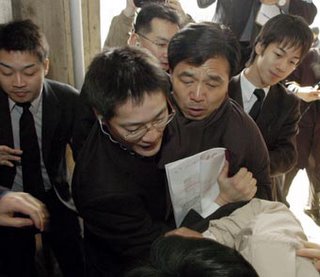
This did not please some "patriotic" Koreans: Choi Jae-ik, a member of the municipal assembly of Seoul, who was visiting Japan to stop "Takeshima's Day" from being enacted, attempted to break into the prefectural congress of Shimane, with a knife in his hand.
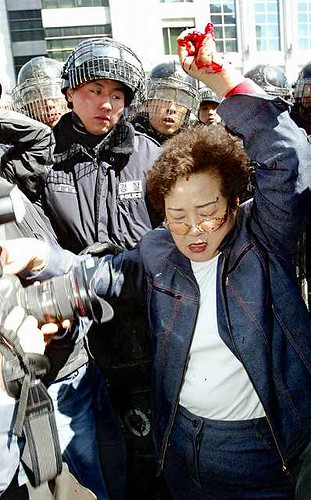
A fanatic Korean woman cuts off her fingers to display protest to "Takeshima's Day".
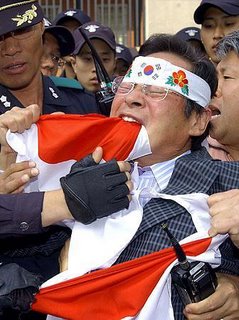
One of the leaders of "Hwal-bin-dan", a Korean right-wing activist group, is biting away Japan's national flag into pieces.
Maybe it's a Korean custom to enjoy eating flags when they find something frustrating. :p
See also: Takeshima
Monday, January 09, 2006
Takeshima
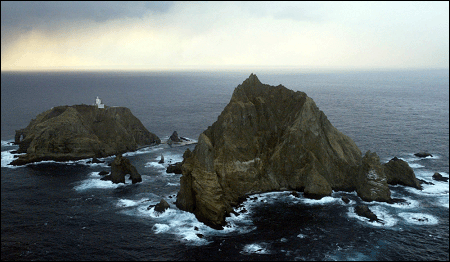
Maybe it's rather more familiar as "Liancourt Rocks" to western people.
In 1952, amid severe anti-communist battles in the Korean war, Koreans illegally occupied these two islets, dumping most of their national defense on the UN forces.
Japan has been advocating for decades to resolve this territorial dispute at the International Court of Justice, while Korea has been defying it.
See Shimane pref's official web site for more info.
Friday, January 06, 2006
Recommended Flash Movie
Are Japanese textbooks distorting history?
This is a brief flash movie created by a Japanese citizen, which describes how Japanese textbooks treat history of Japan, namely the one in the days of WW2.
It also points out that Chinese textbook makes no mentions on the Communists' suppression of democratization activities, massacres in Tibet, etc.
Chinese (simplified) version of the movie is also available.
